
With the move came more business opportunities as this new rental had much more room. However, getting enough people, and more importantly
getting the 'right' people, seemed a daunting task, but Dan wasn't swayed. As his business was rapidly growing, so were his studio calls for
standby work which had him working with numerous artists.
Eddie Diehl was already a household name as a masterful
jazz guitar player in the city when Dan met up with him at a jam session. After chatting with him for awhile Dan learned that Eddie was also a
luthier and asked Eddie to work for him. In my interview with him Eddie said "I felt I could work by day and still play guitar at night, so
it seemed an equitable arrangement." Eddie went on to say "Dan had his own way of doing things and so I just did repairs the way he
wanted them done."
Even with Eddie on board Dan knew that he needed more help. According to Russell George "Dan's shop had quickly become a hot spot for
musicians to hang out and bring in instruments, not only for repair work, but for more maintenance things that working musicians and session
guitar players just didn't have time for, string changes and intonation adjustments. Here they could drop off their guitars, have it worked on
and even delivered to a studio in a fraction of the time it used to take."
While in his shop one day, Dan asked Russell if he knew of someone that would work for him. Russell said "well, I have a friend just out of
the military who is a guitar player but he has no training in repair work." Dan responded, saying "as long as he is trustworthy, we can
teach him guitar repair". Meanwhile, just out of the service was Mr. Carl Thompson who one day received a call from his old friend Russell
George. After getting all caught up with everything, Russel informed him about a job opening at Dan's shop. When Carl showed an interest, Russel
said he would tell Dan and that Carl could expect a call from Dan. In my interview with Carl he related the story saying "I was sitting on my
porch after supper one night when he" (Dan) "called me up and asked me to go to work for him".
Like Dan, Carl had hoped to get to New York and become a famous jazz player, but when he arrived in New York, he found himself surrounded by all
the greatest jazz players of the age "It was a very humbling experience" Carl stated, along with a warm and casual chuckle. According to
Carl, he did his apprenticeship under Eddie Diehl, and while most of it went well, the toughest part was learning fret work. Carl mentions
"alot of it's just learning the tools, and then using the correct tool for the job at hand. Fortunately, Eddie was extremely friendly and
patient with me and together, we eventually we made a really good team."
Carl continues, stating "everyone came into Dan's shop, it became more like a place to jam with other musicians, and as a result the shop
also became more like a booking agency and musicians would even swap playing schedules for studio work, some with Dan's help, as Dan's shop
would serve as a messenger service if need be. Other times it was done without his services. It was commonplace to see big name talent there,
and the phone was ringing off the hook all the time".
Jerome Harris writes in to say "It was inspiring and a bit intimidating to witness the relaxed camaraderie and high skills of the various
professional players who frequented the shop while I bought picks and sets of Dan's strings." High School acquaintance William Gamble
continued in his correspondence saying "After I moved to New York is when I really got to know Dan. Being guitar players, and friends, I
was often hanging out at his shop."
Carl remembers going to lunch one day with Dan and his wife Cynthia, saying "they had as many restaurants on or near guitar row as they did
music stores and one day while waiting for our lunch to arrive, I noticed a man having a bowl of soup. I soon entered a state of shock when I
discovered that the man having soup a few tables down from us was none other than John Sebastian of the
Loving Spoonful. I remember being dazed while quietly
trying to point him out when all of a sudden Cynthia noticed me and said 'oh yeah....... that's John'."
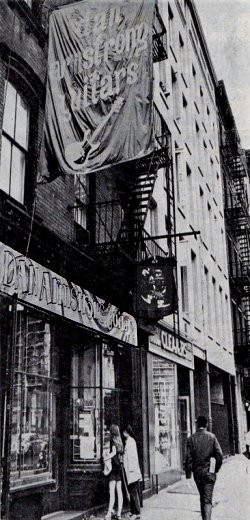
|
Together Dan Armstrong, Eddie Diehl, Carl Thompson, and Steve Kubica ran Dan's new shop at 500 LaGuardia Place in Greenwich Village which had
store front windows for display. Eventually Dan hired Jimmy Ryan as the store manager, who in turn - hired others over time.
In my interview with Steve Kubica he stated that "Dan once told me that he liked this new location much better as it was more relaxed. Once
the move was made he changed the name from Dan Armstrong Guitar Service to Dan Armstrong Guitars. The change
in name was because his old shop was strictly a service type shop, it was never an actual 'store' but by the time of the move, it had become a
store. So while instruments could still be serviced like before, Dan was now 'selling' instruments and amplifiers as well. As such, Dan dropped
the word 'Service' and just called it Dan Armstrong Guitars."
Notice at top the Dan Armstrong banner with the new store name and with an image of a Dan Armstrong clear acrylic guitar below his name,
suggesting that this particular photo was taken at a time when the Dan Armstrong · Ampeg instruments were being marketed.
When asked about it Jimmy Ryan, who was the store manager at the time remembered the banner and stated "The big banner with the plexi guitar
I definitely remember because I designed it!"
|
"It was my idea to put it up there so people walking up Bleeker St. would notice it way down the block on an otherwise non-commercial street
(LaGuardia Place). Bleeker was wall to wall restaurants and clubs, so it seemed a good idea to try and grab some of that traffic whenever
possible, hence a gigantic banner. It was my job to try and boost sales, so that was one of my ideas." Lastly, Jimmy added
"I actually had to talk Dan into it. He wasn’t sure it would do anything, and it was pretty expensive for a little shop like ours, but I
prevailed and it actually worked!"
Below that banner, and a bit to the right is a small flag. According to Steve Kubica, it was a 'baroque duck' standing in the center of a blue
flag. Seen in the black & white photo above, it's a dark image, but one can easily make out the white boots the duck is wearing. In the
enlarged view, one can easily make out the duck's bill as it stares at you. Just below
that, and to the left, the store-front sign reads 'Dan Armstrong Guitars'. To see what the store front looks like today click
here.
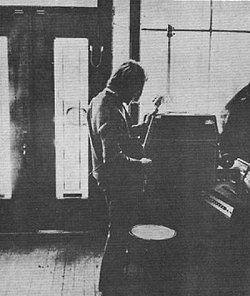
|
A rare photo seen from the inside of Dan Armstrong Guitars at 500 LaGuardia Place in New York where a young Dave Hussong tries out music gear.
This photo can also be seen in the Brochures section of this site where it's accompanied by a full article and interview with Dan.
Some notable objects in the photo are an old Vox amp and maybe a small Ampeg amp in front of him, plus the faint outline of one of Dan's (then)
newest creations - a Dan Armstrong · Ampeg bass on display in a store-front window. The presence of the acrylic bass tells us that this photo
was likely taken in 1970-71. Photo by Michael J. Keys.
|
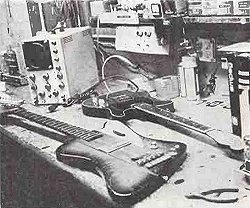
|
Instruments on the workbench at Dan's shop in the Village.
|
Although Dan said that this new location was more relaxed, he probably sometimes missed being on guitar row, as according to Steve Kubica
"One thing Dan did like about being on 48th Street was that it was near Houston & Canal Streets. During this time period much of
the manufacturing that was done in New York was closing down and leaving the city to relocate elsewhere - usually in the South. As a result of
the closing and moving of these businesses, much of the machinery & tools were sold off locally - and much of it made its way to the various
dealers on Huston & Canal Street. Dan enjoyed this because he could get various tools rather easily and inexpensively that he would use in his
shop and he didn't have to go far to acquire them."
Steve added "Many of Dan's purchases were smaller things like machinist type straight edges, which were useful for doing fret work and such.
But there was this one milling machine that Dan wanted pretty badly as he felt it could do a good job at various custom type work on bridges or
tuners, or almost anything else that might need to be altered. He tried to get the dealer down on his price but the dealer wouldn't budge - and
so it was a piece of equipment that Dan never got his hands on."
One day while having lunch with Dan, Steve said that "Dan became fascinated with guitar amplifiers and all he could talk about was an amp
that would use 'rocker' type switches on it. Even more so, he seemed border-line obsessed with Toroidal transformers and would spend the entire
time over lunch talking about them." Ironically, in the future the Dan Armstrong amplifiers would employ rocker style switches on them.
Back at the new shop however, work was getting backed up. Clearly more help was needed, and Dan soon hired a young man by the name of Kurt
Munkacsi - who was attending audio engineering school at the time. Dan hired him on to be his salesman, though he also helped out in others
areas as well. Kurt also remembers the big name clientele that would frequently enter Dan's shop. One notable customer to this day stands out in
Kurt's memory, and that was Lou Reed. Kurt goes on to explain
saying "many times Lou would stop in, and ask Dan to install another pickup in his guitar, as he felt the more pickups one had on their
guitar, the more powerful the signal would be. Dan repeatedly informed him that it wasn't the number of pickups, but the type of pickup or
pickups one has that makes the signal more, or less powerful. Dan had already installed many pickups in Lou's guitar, and there really wasn't
room for anymore. Looking back I think it became their way of visiting, as they would be smiling while at the same time giving each other a hard
time about it."
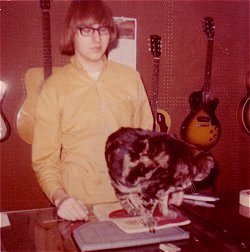
|
Kurt Munkacsi stands behind the counter at Dan Armstrong Guitars located at 500 Laguardia Place in Greenwich Village. Here Kurt is seen watching
'the store cat'. When asked about the presence of the cat, Matt Umanov replies "when you have mice you need a store cat".
Notice the books the cat is resting on. According to Kurt "The gray book was a store ledger with a list of all the instruments that were for
sale. It contained their prices, who owned them if they were on consignment, who had them if they were out on approval etc. The other book is
unknown but I think was an exercise book for guitar." Photos here and below are courtesy of Mr. Matt Umanov.
|
Steve Kubica remembers that "Dan always had a soft spot for cats and would usually leave some inexpensive cat food when he would lock up and
leave for the night. I remember opening the shop one morning and as I opened the door, a cat rapidly darted at me and shot out past me."
Steve chuckles as he finished by saying "It got my nerves jump started for the day."
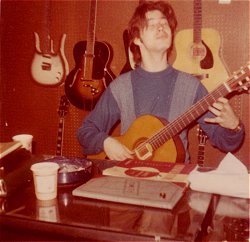
|
Also seen behind the counter is Paul Metzge who, according to Kurt, "is a very good jazz and classical guitar player. I don't recall him
working at the shop but I think he was a friend of Eddie Diehl".
Matt Umanov remembers that Paul "went on to play with
Astrud Gilberto
but got fired on the way to Brazil on his first gig with her after he removed his shoes on the plane; she was not pleased with the smell of his
feet and sent him right back home after the plane landed". His whereabouts today remain unknown.
|
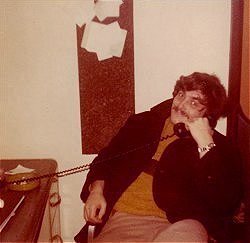
|
Dan Armstrong pauses for a photo while on the phone in his office at 500 Laguardia Place in Greenwich Village. In my interview with Carl
Thompson, he stated "the phone was ringing off the hook all the time".
Sharp observers may have noticed the memo's pinned onto the tack board behind him. This was the usual place where Dan kept track of playing
schedules for studio work and more. Carl also mentioned that "there was so much studio work and sessions going on that musicians would often
swap playing schedules and times. Dan would often act as the messenger service for them as everyone visited his shop".
|
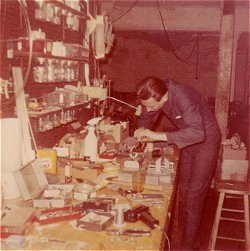
|
Seen here is New York's legendary jazz guitar player Eddie Diehl who worked for Dan doing guitar repair work. Eddie can be seen working on a
customers Gibson guitar in the basement of Dan's shop. According to Matt Umanov "the workshop was in the basement" as the upstairs was
more for sales and offices.
Notice the soldering iron in the foreground as well as a roll of solder, a can of oil and many other recognizable products that were, and still
are, needed for repair type work. The 60's style water glass lying in front of a hammer and positioned about halfway from the
soldering gun to Eddie is a testament to the time frame.
|
continue
menu
Names and images are TMand © Dan Armstrong / Ampeg. All rights reserved.
All other names and images are TMand © of their respective owners. All rights reserved.
|
| |

